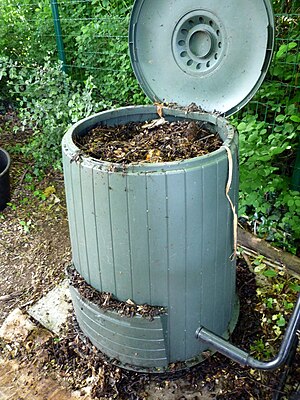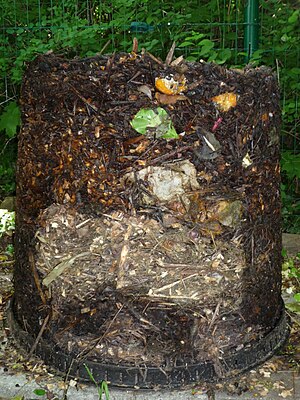 Image via WikipediaIt is a good idea to have a container with an airtight lid to store the food waste in your kitchen. You do not want to attract insects or pests inside your home nor do you want to be running to your compost bin every time you make a meal or snack. If your kitchen container is airtight you will also cut down on unpleasant odors.
Image via WikipediaIt is a good idea to have a container with an airtight lid to store the food waste in your kitchen. You do not want to attract insects or pests inside your home nor do you want to be running to your compost bin every time you make a meal or snack. If your kitchen container is airtight you will also cut down on unpleasant odors.Here is a list of the most common compostable items from the kitchen:
* Vegetable peels and seeds
* Fruit peels, cores, and seeds
* Coffee grounds – you can compost the paper filter too
* Tea bags or loose tea leaves
* Crushed egg shells – do not add left-over eggs cooked or raw
* Breads
 Image via WikipediaYou may be tempted to add other food scraps into the bin, but don’t. You should not add any animal meat or bones, oily products, or fish remains - not only will these be sure to attract unwanted pests but they will make your compost smell bad. Whenever you are adding your green food to the compost bin, make sure you cover it under a thick layer of "Brown food" (yard waste or other carbon producing agent such as dry leaves, wood chips, sawdust, or small twigs).
Image via WikipediaYou may be tempted to add other food scraps into the bin, but don’t. You should not add any animal meat or bones, oily products, or fish remains - not only will these be sure to attract unwanted pests but they will make your compost smell bad. Whenever you are adding your green food to the compost bin, make sure you cover it under a thick layer of "Brown food" (yard waste or other carbon producing agent such as dry leaves, wood chips, sawdust, or small twigs).If your food scraps are very wet or moist, in addition to putting brown food on top of the scraps mix some in with the waste too. This will enable better air circulation throughout your pile.

No comments:
Post a Comment